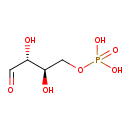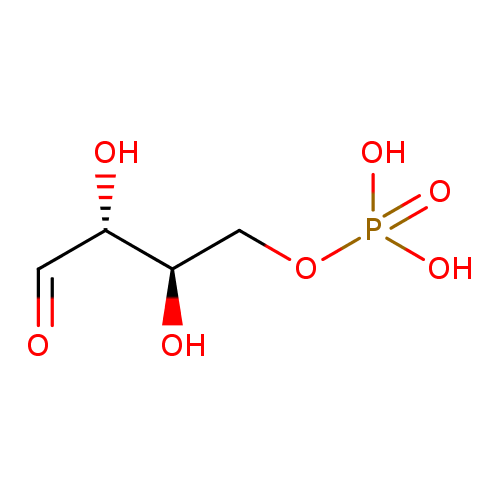|
Record Information |
|---|
| Version |
1.0 |
|---|
| Update Date |
1/22/2018 11:54:54 AM |
|---|
|
Metabolite ID | PAMDB110850 |
|---|
|
Identification |
|---|
| Name: |
D-erythrose 4-phosphate |
|---|
| Description: | D-Erythrose 4-phosphate is a phosphorylated derivative of erythrose that serves as an important intermediate in the pentose phosphate pathway. It is also used in phenylalanine, tyrosine and tryptophan biosynthesis, and it plays a role in vitamin B6 metabolism (KEGG). |
|---|
|
Structure |
|
|---|
| Synonyms: | -
erythrose-4P
-
threose 4-phosphate
-
erythrose-4-phosphate
-
erythrose-4-P
-
D-erythrose-4-P
|
|---|
|
Chemical Formula: |
C4H7O7P
|
|---|
| Average Molecular Weight: |
198.07 |
|---|
| Monoisotopic Molecular
Weight: |
200.0085891536 |
|---|
| InChI Key: |
NGHMDNPXVRFFGS-IUYQGCFVSA-L |
|---|
| InChI: |
InChI=1S/C4H9O7P/c5-1-3(6)4(7)2-11-12(8,9)10/h1,3-4,6-7H,2H2,(H2,8,9,10)/p-2/t3-,4+/m0/s1 |
|---|
| CAS
number: |
585-18-2 |
|---|
| IUPAC Name: | (2R,3R)-2,3-dihydroxy-4-oxobutyl phosphate |
|---|
|
Traditional IUPAC Name: |
4-O-phosphono-D-erythrose |
|---|
| SMILES: | [CH](C(C(COP([O-])([O-])=O)O)O)=O |
|---|
|
Chemical Taxonomy |
|---|
|
Taxonomy Description | This compound belongs to the class of chemical entities known as monosaccharide phosphates. These are monosaccharides comprising a phosphated group linked to the carbohydrate unit. |
|---|
|
Kingdom |
Chemical entities |
|---|
| Super Class | Organic compounds |
|---|
|
Class |
Organic oxygen compounds |
|---|
| Sub Class | Organooxygen compounds |
|---|
|
Direct Parent |
Monosaccharide phosphates |
|---|
| Alternative Parents |
|
|---|
| Substituents |
- Monosaccharide phosphate
- Monoalkyl phosphate
- Alkyl phosphate
- Phosphoric acid ester
- Organic phosphoric acid derivative
- Beta-hydroxy aldehyde
- Alpha-hydroxyaldehyde
- Secondary alcohol
- 1,2-diol
- Organic oxide
- Hydrocarbon derivative
- Carbonyl group
- Aldehyde
- Alcohol
- Aliphatic acyclic compound
|
|---|
| Molecular Framework |
Aliphatic acyclic compounds |
|---|
| External Descriptors |
|
|---|
|
Physical Properties |
|---|
| State: |
Solid |
|---|
| Charge: | -2 |
|---|
|
Melting point: |
Not Available |
|---|
| Experimental Properties: |
| Property | Value | Reference |
|---|
| Melting Point | Not Available | Not Available | | Boiling Point | Not Available | Not Available | | Water Solubility | Not Available | Not Available | | LogP | Not Available | Not Available |
|
|---|
| Predicted Properties |
|
|---|
|
Biological Properties |
|---|
| Cellular Locations: |
Not Available |
|---|
| Reactions: | |
|---|
|
Pathways: |
|
|---|
|
Spectra |
|---|
| Spectra: |
|
|---|
|
References |
|---|
| References: |
- Tanaka N, Haga A, Uemura H, Akiyama H, Funasaka T, Nagase H, Raz A, Nakamura KT: Inhibition mechanism of cytokine activity of human autocrine motility factor examined by crystal structure analyses and site-directed mutagenesis studies. J Mol Biol. 2002 May 10;318(4):985-97. [12054796 ]
- Nakayama Y, Kinoshita A, Tomita M: Dynamic simulation of red blood cell metabolism and its application to the analysis of a pathological condition. Theor Biol Med Model. 2005 May 9;2(1):18. [15882454 ]
- Huck JH, Struys EA, Verhoeven NM, Jakobs C, van der Knaap MS: Profiling of pentose phosphate pathway intermediates in blood spots by tandem mass spectrometry: application to transaldolase deficiency. Clin Chem. 2003 Aug;49(8):1375-80. [12881455 ]
- Takeuchi T, Nishino K, Itokawa Y: Improved determination of transketolase activity in erythrocytes. Clin Chem. 1984 May;30(5):658-61. [6713626 ]
- Talukder AH, Bagheri-Yarmand R, Williams RR, Ragoussis J, Kumar R, Raz A: Antihuman epidermal growth factor receptor 2 antibody herceptin inhibits autocrine motility factor (AMF) expression and potentiates antitumor effects of AMF inhibitors. Clin Cancer Res. 2002 Oct;8(10):3285-9. [12374700 ]
- Stepanova NG: [Determination of aldolase A activity in the serum of patients with myocardial infarction] Vopr Med Khim. 1986 Sep-Oct;32(5):89-93. [3776121 ]
- Mikami M, Sadahira Y, Haga A, Otsuki T, Wada H, Sugihara T: Hypoxia-inducible factor-1 drives the motility of the erythroid progenitor cell line, UT-7/Epo, via autocrine motility factor. Exp Hematol. 2005 May;33(5):531-41. [15850830 ]
- Zanella A, Izzo C, Rebulla P, Perroni L, Mariani M, Canestri G, Sansone G, Sirchia G: The first stable variant of erythrocyte glucose-phosphate isomerase associated with severe hemolytic anemia. Am J Hematol. 1980;9(1):1-11. [7435496 ]
- Williams JF, Blackmore PF, Duke CC, MacLeod JK: Fact, uncertainty and speculation concerning the biochemistry of D-erythrose-4-phosphate and its metabolic roles. Int J Biochem. 1980;12(3):339-44. [6998788 ]
|
|---|
| Synthesis Reference: |
Not Available |
|---|
| Material Safety Data Sheet (MSDS) |
Not Available |
|---|
|
Links |
|---|
| External Links: |
|
|---|


